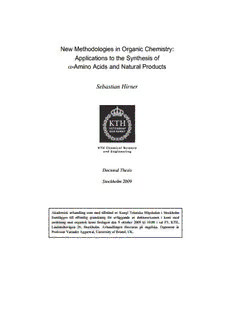
New Methodologies in Organic Chemistry - DiVA Portal PDF
Preview New Methodologies in Organic Chemistry - DiVA Portal
New Methodologies in Organic Chemistry: Applications to the Synthesis of α-Amino Acids and Natural Products Sebastian Hirner Doctoral Thesis Stockholm 2009 Akademisk avhandling som med tillstånd av Kungl Tekniska Högskolan i Stockholm framlägges till offentlig granskning för avläggande av doktorsexamen i kemi med inriktning mot organisk kemi fredagen den 9 oktober 2009 kl 10.00 i sal F3, KTH, Lindstedtsvägen 26, Stockholm. Avhandlingen försvaras på engelska. Opponent är Professor Varinder Aggarwal, University of Bristol, UK. ISBN 978-91-7415-404-7 ISSN 1654-1081 TRITA-CHE-Report 2009:46 © Sebastian Hirner, 2009 Universitetsservice US-AB, Stockholm Sebastian Hirner, 2009: ”New Methodologies in Organic Chemistry: Applications to the Synthesis of α-Amino Acids and Natural Products“, KTH Chemical Science and Engineering, Royal Institute of Technology, SE-100 44 Stockholm, Sweden. Abstract This thesis deals with the development and application of new synthetic methodology in organic chemistry. The first part describes the development of a new protocol for the synthesis of 3-pyrrolines by means of a microwave-assisted ring-expansion reaction of 2-vinylaziridines. In addition, this methodology is implemented as a key-step in a formal total synthesis of the antibiotic (−)-anisomycin. In the second part, a new methodology for the synthesis of arylglycines from Weinreb amides is described. In this procedure, a Grignard reagent is added to the iminium ion formed from the Weinreb amide upon treatment with a base. When a chiral amide is used, the nucleophilic addition proceeds with high diastereoselectivity. Finally, an easy and straightforward synthesis of α-amino amides via a base- mediated rearrangement of modified Weinreb amides into N,O-acetals is presented. Subsequent arylation, alkylation, alkenylation or alkynylation of this intermediate affords the corresponding α-amino amides in excellent yields. Furthermore, a more generalized protocol for the α-arylation of Weinreb amides lacking an α-amino moiety is also discussed. Keywords: Organic synthesis, 2-Vinylaziridines, 3-Pyrrolines, Ring- expansion, Rearrangement, Anisomycin, Total synthesis, α-Amino acids, Arylglycines, Weinreb amides, α-Arylation, Grignard reagents, Umpolung, N,O-Acetals. Abbreviations Ac acetyl BuLi butyl lithium cat catalyst Cy cyclohexyl DBU 1,8-diazabicyclo[5.4.0]undec-7-ene dr diastereomeric ratio ee enantiomeric excess equiv equivalent(s) Et ethyl hfacac hexafluoroacetylacetonate i-Pr isopropyl LHMDS lithium hexamethyldisilazide LDA lithium diisopropylamide MAO monoamine oxidase Me methyl Ms methanesulfonyl NDMBA N,N'-dimethylbarbituric acid NMDA N-methyl-D-aspartate n.d. not determined n-Hex n-hexyl t time T temperature t-Bu tert-butyl THF tetrahydrofuranes TMP 2,2,6,6-tetramethylpiperidine tol toluene Ts p-toluenesulfonyl List of Publications This thesis is based on the following papers, referred to in the text by their Roman numerals I-IV: I. Microwave Assisted Rearrangement of Vinylaziridines to 3-Pyrrolines: Formal Total Synthesis of (–)-Anisomycin Sebastian Hirner and Peter Somfai Synlett 2005, 20, 3099. II. Synthesis of Arylglycines by the α-Arylation of Weinreb Amides Sebastian Hirner, Olaf Panknin, Magnus Edefuhr and Peter Somfai Angew. Chem. Int. Ed. 2008, 47, 1907. III. Synthesis of α-Amino Acids via Umpolung of Weinreb Amide Enolates Sebastian Hirner, Donata K. Kirchner and Peter Somfai Eur. J. Org. Chem. 2008, 33, 5583. IV. Synthesis of α-Amino Amides via N,O-Acetals Derived from Weinreb Amides Sebastian Hirner and Peter Somfai J. Org. Chem. 2009, accepted. Paper not included in this thesis: V. Total Synthesis of the Potent Anticancer Aglaia Metabolites (−)-Silvestrol and (−)-Episilvestrol and the Active Analogue (−)-4’-Desmethoxyepisilvestrol Tim E. Adams, Mariana El Sous, Bill C. Hawkins, Sebastian Hirner, Georgina Holloway, Mui Ling Khoo, David J. Owen, G. Paul Savage, Peter J. Scammells and Mark A. Rizzacasa J. Am. Chem. Soc. 2009, 131, 1607. Table of Contents 1. Introduction.........................................................................................1 1.1. Organic synthesis....................................................................................1 1.2. Chirality....................................................................................................4 1.3. Aim of this thesis.....................................................................................6 2. Ring-expansion of 2-vinylaziridines: Synthesis of 3-pyrrolines...........7 2.1. Introduction..............................................................................................7 2.2. 2-Vinylaziridines......................................................................................8 2.2.1. Synthesis of 2-vinylaziridines..........................................................................9 2.2.2. Ring-expansions to 3-pyrrolines: a short review.............................................9 2.3. Ring-expansion of 2-vinylaziridines to 3-pyrrolines...............................12 2.3.1. Synthesis of 2-vinylaziridines 37...................................................................12 2.3.2. Cis/trans-equilibration of 2-vinylaziridines.....................................................13 2.3.3. Optimization..................................................................................................14 2.3.4. Screening of different substituents................................................................16 2.3.5. Substituted vinylaziridines.............................................................................16 2.4. Formal total synthesis of (–)-anisomycin...............................................17 2.4.1. Introduction....................................................................................................17 2.4.2. Previous syntheses of anisomycin................................................................18 2.4.3. Retrosynthetic analysis.................................................................................19 2.4.4. Synthesis of (–)-anisomycin..........................................................................19 2.5. Conclusions...........................................................................................21 3. Synthesis of α-Amino Acids via Umpolung of Weinreb Amide Enolates............................................................................................23 3.1. Introduction............................................................................................23 3.2. Arylglycines...........................................................................................24 3.2.1. Introduction....................................................................................................24 3.2.2. Synthesis of arylglycines...............................................................................25 3.3. Weinreb amides in organic synthesis....................................................27 3.3.1. Introduction....................................................................................................27 3.3.2. Demethoxylation of Weinreb amides.............................................................27 3.3.3. Generation of α-lactams from Weinreb amides............................................29 3.4. Synthesis of α-amino acids from Weinreb amides................................30 3.4.1. Introduction....................................................................................................30 3.4.2. Screening of base.........................................................................................30 3.4.3. Use of N-tert-butoxy Weinreb amides...........................................................31 3.4.4. Screening of nucleophiles.............................................................................33 3.4.5. Mechanistic considerations...........................................................................34 3.5. Asymmetric synthesis of arylglycines....................................................35 3.5.1. Use of (−)-α-methylbenzylamine as chiral auxiliary.......................................35 3.5.2. Use of (R,R)-α,α′-dimethyldibenzylamine as chiral auxiliary.........................37 3.5.3. Enantioselective synthesis............................................................................38 3.6. Synthesis of quaternary α-amino acids.................................................39 3.7. Conclusions...........................................................................................39 4. Synthesis of α-Amino Amides via N,O-Acetals Derived from Weinreb Amides................................................................................41 4.1. Introduction............................................................................................41 4.2. Rearrangement of Weinreb amides.......................................................41 4.2.1. Results and discussion..................................................................................42 4.2.2. Mechanistic considerations...........................................................................44 4.3. Synthesis of α-amino amides from N,O-acetals....................................46 4.3.1. Results and discussion..................................................................................46 4.3.2. Diastereoselective synthesis.........................................................................48 4.4. α-Arylation of Weinreb amides..............................................................49 4.4.1. Introduction....................................................................................................49 4.4.2. Results and discussion..................................................................................50 4.5. Synthesis of α-amino-γ-lactones...........................................................51 4.5.1. Introduction....................................................................................................51 4.5.2. Synthesis of α-amino-γ-lactones...................................................................51 4.6. Conclusions...........................................................................................54 5. Concluding Remarks.........................................................................55 Acknowledgements Appendices Für Antje
Description: